
Tallinn is the capital and most populous city of Estonia. Situated on a bay in north Estonia, on the shore of the Gulf of Finland of the Baltic Sea, Tallinn has a population of about 454,000 and administratively lies in the Harju maakond (county). Tallinn is the main financial, industrial, and cultural centre of Estonia. It is located 187 km (116 mi) northwest of the country's second largest city, Tartu, however only 80 km (50 mi) south of Helsinki, Finland, also 320 km (200 mi) west of Saint Petersburg, Russia, 300 km (190 mi) north of Riga, Latvia, and 380 km (240 mi) east of Stockholm, Sweden. From the 13th century until the first half of the 20th century, Tallinn was known in most of the world by variants of its other historical name Reval.

Tartu is the second largest city in Estonia after Tallinn. Tartu has a population of 97,435. It is 186 kilometres southeast of Tallinn and 245 kilometres northeast of Riga, Latvia. Tartu lies on the Emajõgi river, which connects the two largest lakes in Estonia, Lake Võrtsjärv and Lake Peipus. From the 13th century until the end of the 19th century, Tartu was known in most of the world by variants of its historical name Dorpat.

Pikk Hermann or Tall Hermann is a tower of the Toompea Castle, on Toompea hill in Tallinn, the capital of Estonia. The first part was built 1360–70. It was rebuilt in the 16th century. A staircase with 215 steps leads to the top of the tower. The tower consists of ten internal floors and a viewing platform at the top.
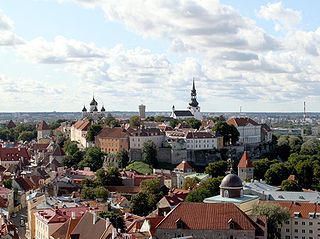
Toompea is a limestone hill in the central part of the city of Tallinn, the capital of Estonia. The hill is an oblong tableland, which measures about 400 by 250 metres, has an area of 7 hectares and is about 20–30 metres higher than the surrounding areas. In folklore the hill is known as the tumulus mound over the grave of Kalev, erected in his memory by his grieving wife.

Harju County, is one of the fifteen counties of Estonia. It is situated in Northern Estonia, on the southern coast of the Gulf of Finland, and borders Lääne-Viru County to the east, Järva County to the southeast, Rapla County to the south, and Lääne County to the southwest. The capital and largest city of Estonia, Tallinn, is situated in Harju County. Harju County is the largest county in Estonia in terms of population, as almost half (45%) of the Estonia's population lives in Harju County.

The Riigikogu is the unicameral parliament of Estonia. In addition to approving legislation, the Parliament appoints high officials, including the prime minister and chief justice of the Supreme Court, and elects the president. Among its other tasks, the Riigikogu also ratifies significant foreign treaties that impose military and proprietary obligations and bring about changes in law, as well as approves the budget presented by the government as law, and monitors the executive power.

The Kumu Art Museum is an art museum in Tallinn, Estonia. It is one of the largest museums in Estonia and one of the largest art museums in Northern Europe. It is one of the five branches of the Art Museum of Estonia, housing its main offices.

The Alexander Nevsky Cathedral is an orthodox cathedral on Toompea hill in central Tallinn, Estonia. It was built to a design by Mikhail Preobrazhensky in a typical Russian Revival style in 1894–1900, when the country was part of the Russian Empire. The cathedral is Tallinn's largest orthodox cupola church. It is dedicated to the grand prince of Kiev, and later saint, Alexander Nevsky who in 1242 won the Battle of the Ice on Lake Peipus, near the present-day border between Estonia and Russia. The late Russian patriarch Alexis II started his priestly ministry in the church.

Toompea castle is a medieval castle on Toompea hill in the central part of Tallinn, the capital of Estonia. In modern times, it houses the Parliament of Estonia.
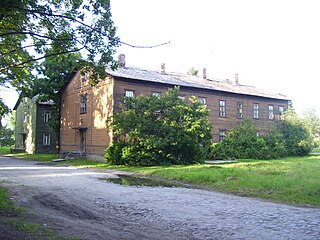
Kopli is a subdistrict of the district of Põhja-Tallinn in Tallinn, the capital of Estonia. It is located on the Kopli Peninsula and is bordered by parts of the Tallinn Bay, the Kopli Bay to the southwest and the Paljassaare Bay to the north. Kopli has a population of 7,240. Kopli's former German name until 1918 was Ziegelskoppel.

Kesklinn is one of the 8 administrative districts of Tallinn, the capital of Estonia. It is situated on the Tallinn Bay and bordered to the northwest by the district of Põhja-Tallinn, to the west by Kristiine, to the southwest by Nõmme, to the east by Lasnamäe and Pirita, and to the south by Rae Parish, beyond Lake Ülemiste. The island of Aegna, located in the Tallinn Bay, also falls within this administrative district. Kesklinn has an area of 30.6 km2 (11.8 sq mi) and a population of 57,731 ; population density is 1,886.6/km2 (4,886/sq mi).
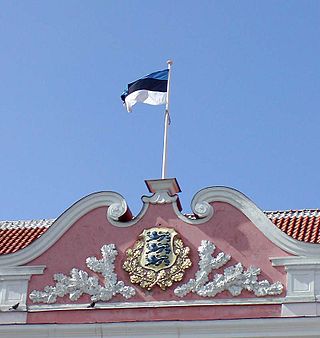
The national symbols of Estonia are flags, coat of arms, icons or cultural expressions that are emblematic, representative or otherwise characteristic of Estonia or Estonian culture.
This article covers the architecture of Estonia.
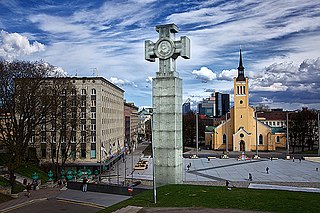
Freedom Square is a plaza on the southern end of the Old Town in Tallinn, Estonia, where state functions and various concerts take place. It is bounded on the east by St. John's Church, on the south by Kaarli Boulevard and an underground shopping center (2008–09), and on the west by a Victory Column (2009) commemorating the Estonian War of Independence 1918–1920.

Roosna-Alliku is a small borough in Paide municipality, Järva County in northern-central Estonia. Prior to the 2017 administrative reform in Estonia of local governments, it was the administrative centre of Roosna-Alliku Parish.

Palmse is a village in Haljala Parish, Lääne-Viru County, in northern Estonia, on the territory of Lahemaa National Park.

Vihula is a village in Haljala Parish, Lääne-Viru County, in northern Estonia, within Lahemaa National Park.
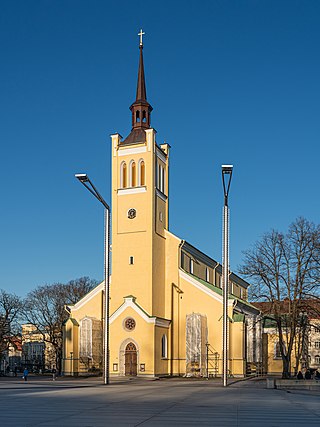
St. John's Church is a large Lutheran parish church in Tallinn, Estonia. It is dedicated to Saint John the Evangelist, a disciple of Jesus Christ and author of the fourth Christian Gospel. Construction began in 1862, and the church was opened in 1867.

This is the overview article of the history of Tallinn, Estonia. For the timeline, see Timeline of Tallinn

Noblessner is a harbour and former industrial area in the northern district of Tallinn, Estonia. Since 2013 it has been redeveloped into a cultural and residential area with a museum, art centre, craft brewery, marina, seafront promenade and cafes and restaurants.




















